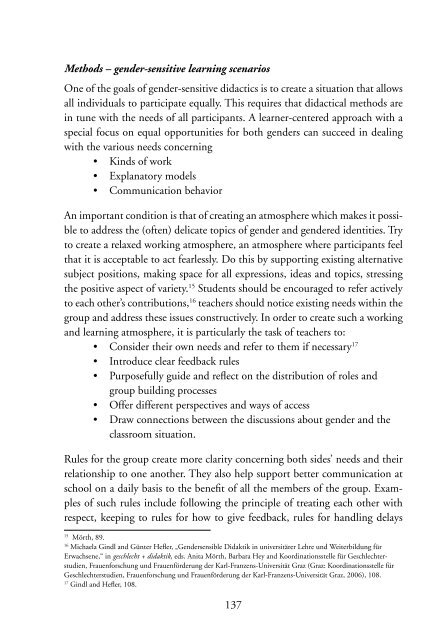Teaching with the third wave new feminists - MailChimp
Teaching with the third wave new feminists - MailChimp
Teaching with the third wave new feminists - MailChimp
You also want an ePaper? Increase the reach of your titles
YUMPU automatically turns print PDFs into web optimized ePapers that Google loves.
Methods – gender-sensitive learning scenariosOne of <strong>the</strong> goals of gender-sensitive didactics is to create a situation that allowsall individuals to participate equally. This requires that didactical methods arein tune <strong>with</strong> <strong>the</strong> needs of all participants. A learner-centered approach <strong>with</strong> aspecial focus on equal opportunities for both genders can succeed in dealing<strong>with</strong> <strong>the</strong> various needs concerning• Kinds of work• Explanatory models• Communication behaviorAn important condition is that of creating an atmosphere which makes it possibleto address <strong>the</strong> (often) delicate topics of gender and gendered identities. Tryto create a relaxed working atmosphere, an atmosphere where participants feelthat it is acceptable to act fearlessly. Do this by supporting existing alternativesubject positions, making space for all expressions, ideas and topics, stressing<strong>the</strong> positive aspect of variety. 15 Students should be encouraged to refer activelyto each o<strong>the</strong>r’s contributions, 16 teachers should notice existing needs <strong>with</strong>in <strong>the</strong>group and address <strong>the</strong>se issues constructively. In order to create such a workingand learning atmosphere, it is particularly <strong>the</strong> task of teachers to:• Consider <strong>the</strong>ir own needs and refer to <strong>the</strong>m if necessary 17• Introduce clear feedback rules• Purposefully guide and reflect on <strong>the</strong> distribution of roles andgroup building processes• Offer different perspectives and ways of access• Draw connections between <strong>the</strong> discussions about gender and <strong>the</strong>classroom situation.Rules for <strong>the</strong> group create more clarity concerning both sides’ needs and <strong>the</strong>irrelationship to one ano<strong>the</strong>r. They also help support better communication atschool on a daily basis to <strong>the</strong> benefit of all <strong>the</strong> members of <strong>the</strong> group. Examplesof such rules include following <strong>the</strong> principle of treating each o<strong>the</strong>r <strong>with</strong>respect, keeping to rules for how to give feedback, rules for handling delays15Mörth, 89.16Michaela Gindl and Günter Hefler, „Gendersensible Didaktik in universitärer Lehre und Weiterbildung fürErwachsene,“ in geschlecht + didaktik, eds. Anita Mörth, Barbara Hey and Koordinationsstelle für Geschlechterstudien,Frauenforschung und Frauenförderung der Karl-Franzens-Universität Graz (Graz: Koordinationsstelle fürGeschlechterstudien, Frauenforschung und Frauenförderung der Karl-Franzens-Universität Graz, 2006), 108.17Gindl and Hefler, 108.137
















